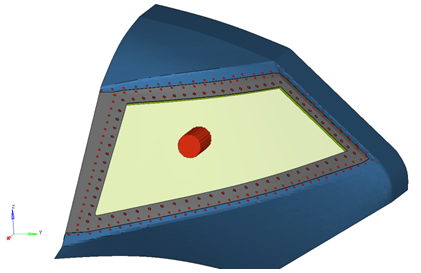
Summary
Birds striking an aircraft windshield is a very important topic, for safety reasons and also financially. The aim of this example is to introduce how to simulate a bird hitting a windshield.
Title
Bird Strike on Windshield
|
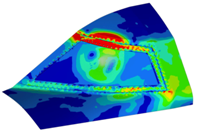
|
Number
49.1
|
Brief Description
Using SPHCEL to simulate a bird hitting a windshield.
|
Keywords
|
RADIOSS Options
| • | Boundary condition (/BCS) |
|
Input File
Bird Strike on Windshield: <install_directory>/demos/hwsolvers/radioss/49_bird_strike_on_windshield/*
|
Technical / Theoretical Level
Advanced
|
Overview
Description of the physical problem
A bird weighing about 4 pounds (1.93kg) with an initial speed of 80m/s impacts a windshield of a plane. The bird model is extremely simplified with one cylinder (diameter: 106mm; height: 195mm) but allows getting familiar with the major options used in a bird strike analysis. Fix the edge of the plane model.
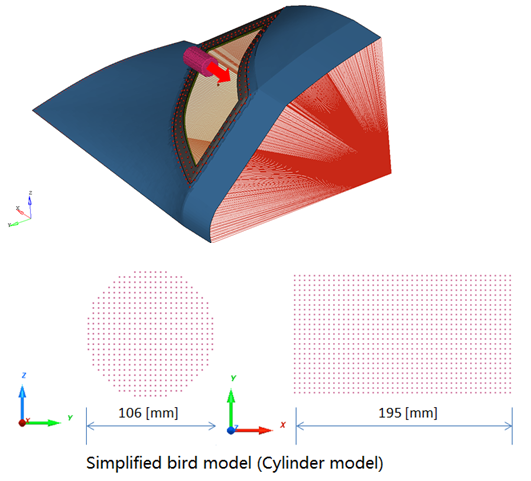
Fig 1: Problem description
Units: mm, ms, kg, KN, GPa
A bird with the following characteristics:
The bird uses material law 6 which is a simple hydro-viscous law based on water properties /MAT/HYDRO.
| • | Initial density = 9.82242e-7 [kg/mm3] |
with SPH cells property /PROP/SPH
Notes:
| 1. | In property, mp is the mass of each particle. There are 11190 particles in the bird model, so the bird weighs 11190*1.725149e-4 = 1.93kg (4 pounds). |
| 2. | Set qa to 2e-30 and qb to 1e-30 for no damping. |
To properly simulate a bird strike, the compression phase of the bird is the most important; therefore, the initial compression wave should properly propagate through the bird. Energy conservation is also important, so that the bird communicates the most realistic amount of energy to the target, thus ensuring that the impact is reasonably conservative.
A low value of qa and qb should be chosen. The behavior of the bird for very low values of the damping is very similar, and there is no evidence of instability; therefore, negligible values of qa and qb (that is 1-30 and 2-30) are considered.
| 3. | In property, h is smoothing length: |

The smoothing length, h is highly recommended to use the minimal distance between any particle and its closest neighbor.
| 4. | SPH correction order is used to satisfy the consistency conditions. It is generally to insure a better representation when the particles are not so well organized than into a hexagonal compact net. High order value is very expensive. In this example, set order to 0. |
For the windshield in this example, use composite material with matrix glass and plastic fabric. Both use /MAT/PLAS_BRIT (composite with isotropic layers).
Glass matrix:
| • | Initial density = 1.74e-6 [kg/mm3] |
| • | Yield stress a = 0.045 [GPa] |
| • | Plasticity hardening b = 0.05 |
| • |  = 0.01 = 0.01 |
| • |  = 0.03 = 0.03 |
| • | element deleted at  =0.06 =0.06 |
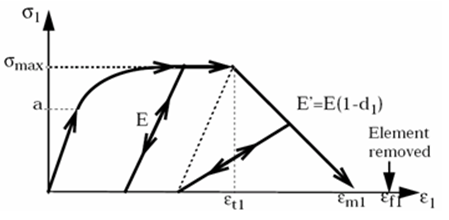 '
'
Fabric plastic:
| • | Initial density = 8e-7 [kg/mm3] |
| • | Yield stress a = 1e30 [Gpa] |
with /PROP/SH_SANDW
| • | Thickness of windshield = 9 [mm] |
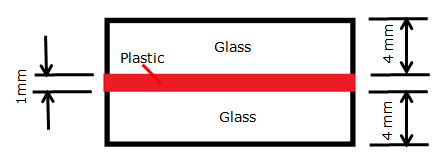
For metal parts (aluminum) in the airplane, use /MAT/PLAS_TAB.
| • | Initial density = 2.7E-6 [kg/mm3] |
For metal parts connection (bolt) in the airplane, use /MAT/PLAS_JOHNS and /PROP/BEAM.
In /MAT/PLAS_JOHNS:
| • | Initial density = 7.8E-6 [kg/mm3] |
| • | Yield stress a = 0.58 [Gpa] |
| • | hardening parameter b =0.6 |
| • | Strain rate coefficient =0.017 |
In /PROP/BEAM:
| • | Iyy = Izz = 201.061 [mm4] |
Analysis, Assumptions and Modeling Description
Modeling methodology
A 4 pound bird model with 11190 particles, the distributions follow a hexagonal compact net. The cell distribution must be cubic centered. The diameter for each particle is about 5.0 mm.
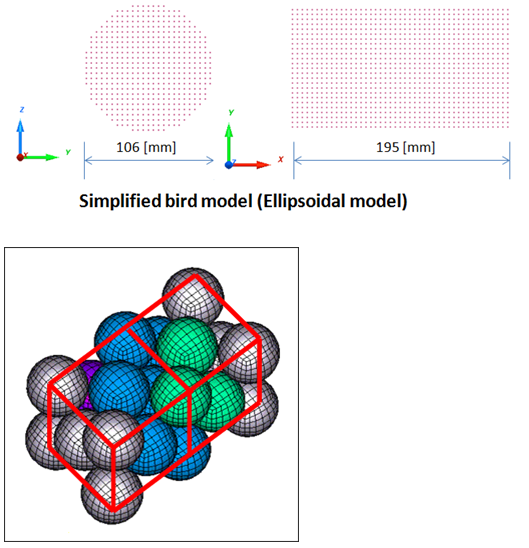
Fig 2: Perspective view of the cubic centered faces net
In order to define the SPH bird, the following keywords are needed:
| o | Use /PROP/SPH to define the bird SPH cells property. |
| o | Use /SPHCEL to define SPH cells for bird. Use bird part ID in this keyword. |
| o | Use /SPHGLO to defined global parameter for this simulation. |
| o | Set  = 0.25 (default value). = 0.25 (default value).  is a security coefficient which is used when searching for neighbors, so that for each particle more than the actual neighbors are found. The computational time can be reduced. is a security coefficient which is used when searching for neighbors, so that for each particle more than the actual neighbors are found. The computational time can be reduced. |
| • | Contact between SPH bird and structure and impact setup |
| o | Use interface type 7 to simulate the Contact between SPH bird and structure. Set the structure as master and the bird as slave. |
| o | Set Igap=1 (use variable gap). The gap is 1/2(particle diameter)+1/2(thickness of the target). This is the physical value for contact. |
| o | The stiffness between bird and structure are quite different. In order to get results more close to reality. Normally set Istf=0 and Stfac=0.1. This means interface stiffness equals to 0.1 times stiffness of master side (structure). |
| o | Use /INIVEL/TRA to set bird part with initial velocity 80m/s strike on the structure. |
| • | Connection between the windshield and fuselage |
| o | Use spring beam to simulate the weld connection between windshield and fuselage, and use tied contact to connect them. |
In order to decrease the size of animation files and get the best display of SPH particles, use /ANIM/VERS/44 in Engine file.
Simulation Results and Conclusions
Figure 3 shows von Mises stress of the windshield at time 3ms ~ 8ms.
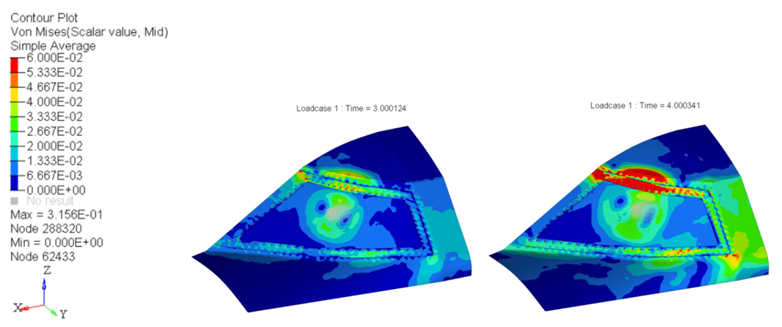
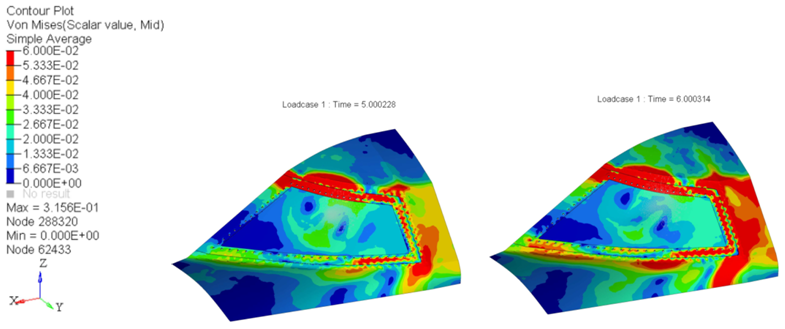
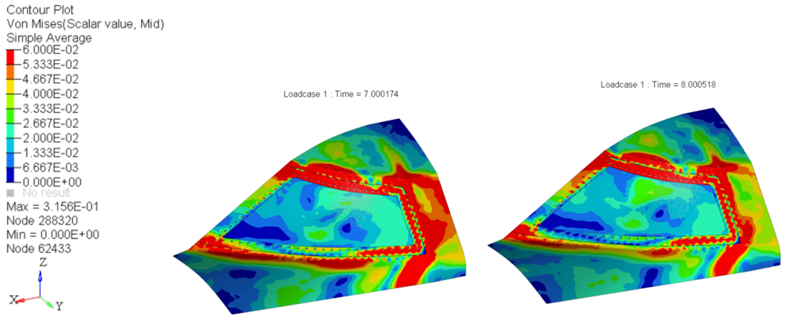
Fig. 3: von Mises Stress at time 3ms~8ms
The Interface Force between the bird and the windshield is shown in Fig. 4.
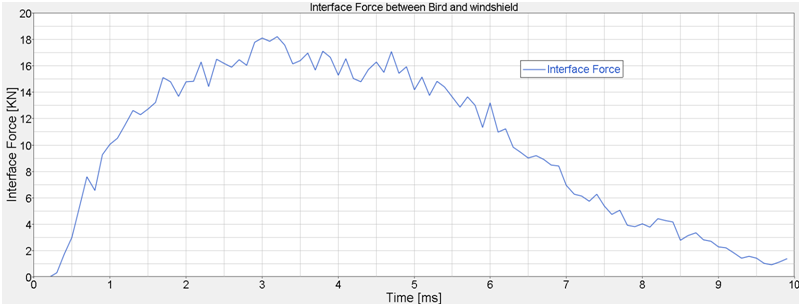
Fig. 4: Interface force between bird and windshield
Conclusion
| • | The size of the mesh and the number of particle seems to be a good compromise between the accuracy of the problem and the CPU considerations (especially for larger models such as 4 and 8 pound birds). |
| • | For interface parameters default values could be used. |
| • | The simplified viscous law is good. |
| • | Impact velocity remains small compared to the sound speed in the material (that is less than 300 m/s). |
| • | The h value should be set to a value larger than the inter-cell distance (to avoid excessive de-cohesion), but not too large to avoid excessive energy absorption by the bird. |
| • | Using this model, the discrepancies between the real tests and the simulations are usually due to parameters independent from bird modeling: boundary conditions, target material laws and test sensitivity and so on. |
| • | The final shape of the bird is more “physical”, so more experimental data would be required, for instance multiple penetration cases. |











 '
'




